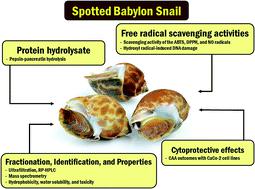Our official English website, www.x-mol.net, welcomes your feedback! (Note: you will need to create a separate account there.)
The antioxidant potential of peptides obtained from the spotted babylon snail (Babylonia areolata) in treating human colon adenocarcinoma (Caco-2) cells
RSC Advances ( IF 3.9 ) Pub Date : 2020-7-7 , DOI: 10.1039/d0ra03261a Putcha Petsantad 1 , Papassara Sangtanoo 2 , Piroonporn Srimongkol 2 , Tanatorn Saisavoey 2 , Onrapak Reamtong 3 , Ninnaj Chaitanawisuti 4 , Aphichart Karnchanatat 2
RSC Advances ( IF 3.9 ) Pub Date : 2020-7-7 , DOI: 10.1039/d0ra03261a Putcha Petsantad 1 , Papassara Sangtanoo 2 , Piroonporn Srimongkol 2 , Tanatorn Saisavoey 2 , Onrapak Reamtong 3 , Ninnaj Chaitanawisuti 4 , Aphichart Karnchanatat 2
Affiliation

|
This research study investigated the free radical-scavenging activities of peptides which were obtained from the protein hydrolysates of the spotted babylon snail using a combination of pepsin and pancreatin proteolysis which can replicate the conditions of gastrointestinal digestion. In this study, spotted babylon protein hydrolysate (SPH) derived from a sequential 3 hour digestion, first with pepsin and then with pancreatin, was examined. SPH was fractionated using molecular weight cut-off membranes for 10 kDa, 5 kDa, 3 kDa, and 0.65 kDa. It was found that the MW < 0.65 kDa fraction provided the greatest levels of 2,2′-azino-bis-3-ethylbenzothiazoline-6-sulphonic acid (ABTS), 2,2-diphenyl-1-picrylhydrazl (DPPH), and nitric oxide (NO) radical scavenging activity. Three subfractions of the MW < 0.65 kDa fraction were then generated via RP-HPLC. The subfraction which subsequently demonstrated the greatest free radical scavenging activity was F3, which was accordingly chosen for further investigation commencing with quadrupole-time-of-flight-electron spin induction-mass spectrometry-based de novo peptide sequencing. This resulted in the identification of a pair of novel peptides: His–Thr–Tyr–His–Glu–Val–Thr–Lys–His (HTYHEVTKH), and Trp–Pro–Val–Leu–Ala–Tyr–His–Phe–Thr (WPVLAYHF). The WPVLAYHF peptide exhibited greater antioxidant activity. The study also confirmed that the F3 sub-fraction was able to prevent hydroxyl radicals from causing DNA damage by conducting tests which involved the pKS, pUC19, and pBR322 plasmids using the Fenton reaction. In addition, cellular antioxidant activity was demonstrated by two synthetic peptides toward the human adenocarcinoma colon (Caco-2) cell line, with the potency of the activity dependent upon the peptide concentration.
中文翻译:

从斑点巴比伦蜗牛 (Babylonia areolata) 中获得的肽在治疗人结肠腺癌细胞 (Caco-2) 中的抗氧化潜力
这项研究调查了使用胃蛋白酶和胰酶蛋白水解的组合从斑点巴比伦蜗牛的蛋白质水解物中获得的肽的自由基清除活性,这可以复制胃肠消化的条件。在这项研究中,检测了源自连续 3 小时消化的斑点巴比伦蛋白水解物 (SPH),首先用胃蛋白酶,然后用胰酶。使用分子量截止膜对 SPH 进行分级分离,分别为 10 kDa、5 kDa、3 kDa 和 0.65 kDa。发现 MW < 0.65 kDa 的部分提供了最高水平的 2,2'-azino-bis-3-ethylbenzothiazoline-6-sulphonic acid (ABTS)、2,2-diphenyl-1-picrylhydrazl (DPPH) 和一氧化氮(NO)自由基清除活性。然后生成 MW < 0.65 kDa 级分的三个亚级分通过RP-HPLC。随后表现出最大自由基清除活性的亚组分是 F 3,因此选择它用于从四极杆-飞行时间-电子自旋感应-质谱为基础的从头肽测序开始的进一步研究。这导致了一对新肽的鉴定:His-Thr-Tyr-His-Glu-Val-Thr-Lys-His (HTYHEVTKH) 和 Trp-Pro-Val-Leu-Ala-Tyr-His-Phe-苏氨酸 (WPVLAYHF)。WPVLAYHF 肽表现出更大的抗氧化活性。该研究还证实,F 3通过使用芬顿反应进行涉及 pKS、pUC19 和 pBR322 质粒的测试,亚组分能够防止羟基自由基引起 DNA 损伤。此外,两种合成肽对人结肠癌 (Caco-2) 细胞系证明了细胞抗氧化活性,其活性效力取决于肽浓度。
更新日期:2020-07-07
中文翻译:

从斑点巴比伦蜗牛 (Babylonia areolata) 中获得的肽在治疗人结肠腺癌细胞 (Caco-2) 中的抗氧化潜力
这项研究调查了使用胃蛋白酶和胰酶蛋白水解的组合从斑点巴比伦蜗牛的蛋白质水解物中获得的肽的自由基清除活性,这可以复制胃肠消化的条件。在这项研究中,检测了源自连续 3 小时消化的斑点巴比伦蛋白水解物 (SPH),首先用胃蛋白酶,然后用胰酶。使用分子量截止膜对 SPH 进行分级分离,分别为 10 kDa、5 kDa、3 kDa 和 0.65 kDa。发现 MW < 0.65 kDa 的部分提供了最高水平的 2,2'-azino-bis-3-ethylbenzothiazoline-6-sulphonic acid (ABTS)、2,2-diphenyl-1-picrylhydrazl (DPPH) 和一氧化氮(NO)自由基清除活性。然后生成 MW < 0.65 kDa 级分的三个亚级分通过RP-HPLC。随后表现出最大自由基清除活性的亚组分是 F 3,因此选择它用于从四极杆-飞行时间-电子自旋感应-质谱为基础的从头肽测序开始的进一步研究。这导致了一对新肽的鉴定:His-Thr-Tyr-His-Glu-Val-Thr-Lys-His (HTYHEVTKH) 和 Trp-Pro-Val-Leu-Ala-Tyr-His-Phe-苏氨酸 (WPVLAYHF)。WPVLAYHF 肽表现出更大的抗氧化活性。该研究还证实,F 3通过使用芬顿反应进行涉及 pKS、pUC19 和 pBR322 质粒的测试,亚组分能够防止羟基自由基引起 DNA 损伤。此外,两种合成肽对人结肠癌 (Caco-2) 细胞系证明了细胞抗氧化活性,其活性效力取决于肽浓度。

























 京公网安备 11010802027423号
京公网安备 11010802027423号